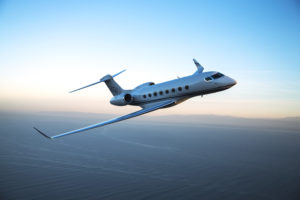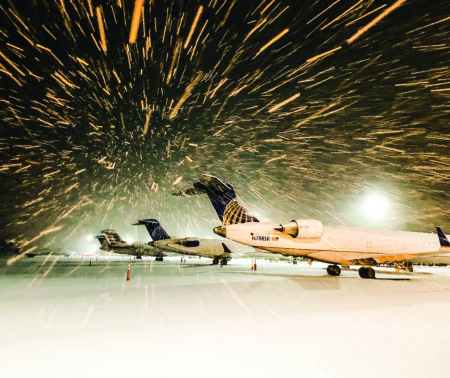Words by Paul Willis
The selection of equipment and a provider for inflight connectivity depends on where you fly and the services your customers want.
While much of the business aviation world has been hit hard by the impact of the Coronavirus pandemic there has been some exceptions. For example, USA-based maintenance repair and overhaul (MRO) provider StandardAero has experienced “a record-breaking year” for installations of its air-to-ground in-flight connectivity (IFC) solutions, says Jerry Sanders, StandardAero’s director of avionics program management and business development.
“This has been the best year we’ve experienced in our company’s history for air-to-ground connectivity,” says Sanders. “We’ve installed more systems and seen more revenue this year than we’ve ever had before.”
Sanders puts this surge in demand down to two factors. One is the availability of discounts from equipment suppliers during the time of the pandemic. The other is the fact that many aircraft have been grounded, meaning “there’s time to actually get these installations done.”
However, StandardAero has not seen a similar spike in demand for its satellite-based IFC solutions. According to Sanders this is because satellite-based IFC is more commonly installed on long-range business jets, which have been impacted more severely by the international flight restrictions imposed in response to the virus.
The IFC market as a whole is set to see a 28% drop in installations for 2020 compared with 2019, according to a recent report published by the UK-based market intelligence firm Valour Consultancy.
Despite the setback, the report is optimistic about the long-term growth of the market, which it predicts will grow by more than 50% in the coming decade. According to the report’s author Craig Foster, a senior research consultant at Valour, this recovery could be helped by a wave of new customers drawn to private flight by the extra layer of safety and convenience it offers in a post-pandemic world. “A lot of the fractional providers have said that they’ve seen record interest from customers that have not flown privately before,” says Foster.
Consumer demand

But even with a boost from high-net worth customers from commercial aviation, the long-term growth of IFC seems assured, not least because consumer demand for ever-greater connectivity shows no signs of abating.
“In the air, just as it is on the ground, people’s desire for data is insatiable,” says Foster. “They want to stream their own content to the aircraft, do live gaming, watch live sports and live news and conduct video chats with colleagues.”
This is all far removed from the beginnings of IFC, which in the 1990s was a rudimentary communication system for satellite phones. The phones were a staple of the business aviation market for some time, says Foster, but it wasn’t until the mid-2000s that “the technology evolved to such a point that you could use the internet on-board.”
The early iterations of this for satellite-based IFC relied on low frequency L-band communication, the same technology used in GPS, radio and telecommunications. This was followed a few years later by Ku-band technology, which was originally created as a broadcast mechanism for satellite television. At around the same time that Ku-band was being rolled out, the Chicago-based IT company Gogo brought to market its air-to-ground IFC system providing coverage for mainland USA and parts of Canada via a cellular network of more than 200 radio towers. More recently, the satellite telecommunications company Inmarsat launched Ka-band, a higher frequency air-to-ground communication system that it says allows users to push more data back and forth from the aircraft.
As a consequence of these developments, business aviation customers can now experience internet-based services in the air almost like they do on the ground. “On some of the air-to-ground systems you’re pulling speeds of somewhere between seven to nine megabytes per second [MB/s], comparable to the speed you’ll find in a coffee shop nowadays,” says Sanders.
While this allows for “a good user experience” it is still a long way off the kind of bandwidth that most of us receive in our homes and offices, which is at least closer to 30MB/s.
Satellite selections

In contrast, satellite-based connectivity systems are faster and capable of reaching connection speeds of around 16MB/s or higher, says Sanders. Besides the speed, the other big advantage of satellite connectivity is that it can work all over the world, unlike the air-to-ground systems, which only work over land. But the hardware involved in satellite-based systems makes them much more expensive to install and maintain compared to air-to-ground.
“With satellite-based systems you have these big radomes and antenna systems that sit on top of the aircraft or in the tail,” says Foster. “Whereas with air-to-ground you have these nickel-blade antennas the size of a coke can that can be easily fitted to the underbelly of the aircraft and connect to the cell towers on the ground.”
However, air-to-ground systems are hampered by network coverage constraints. The only dedicated system available to business aviation is Gogo’s North American network. Even if more networks come online, they will still be limited to overland flight, says Foster: “If you’re flying internationally you have to connect to satellite networks.”
One of the biggest companies servicing the IFC needs of international business jets is the satellite communication company SatCom Direct. The company’s fully-integrated satellite-based solution includes its own brand of routers and antennas for aircraft with a range of 3,000 nautical miles and above, says Chris Moore, SatCom’s president of business aviation.
While the hardware is produced in-house the system is not proprietary, says Moore, meaning that clients can choose which satellite network to connect to. When selecting networks there are two key factors to keep in mind – connectivity and consistency, says Moore: “What customers really want is good connectivity, but it has to be consistent everywhere in the world.”
SatCom works with several companies that have developed satellite networks that are capable of offering comprehensive global coverage, such as Inmarsat, Intelsat, Viasat and Iridium. Even so, Moore says there are variances in the quality and range of the service offered by the different networks based on different factors such as age, number and type of satellites in the network and the level of ground infrastructure in place.
Attaining consistent coverage is not just a technological issue. SatCom and its satellite provider partners must also ensure regulatory compliance when they are flying over different country’s jurisdiction. This is especially important for countries with more restrictive rules around internet use such as China, says Moore. “At the network operators there are regulatory departments looking at this,” he says. “We also make sure that we are compliant with regulations in each jurisdiction.”
High latency challenges

Satellites used for IFC are positioned in either medium or high-earth orbits of between 2,000 and 36,000km above the surface. The high altitude of the satellites means it takes longer for data to travel between the aircraft and the satellite, compared to data on a ground-based fiber optic network. This lag time is known as latency.
High latency can be experienced as a delay in a video conference call for example, and is often cited as one of the major issues when customers are using satellite-based IFC, according to Foster.
“If you’re sending a signal up to a geosynchronous satellite orbiting 36,000km above the surface, it’s got a long way to travel up and back down again. It can cause delays of about 600 milliseconds.”
One solution to high latency is the introduction of low-earth orbit (LEO) satellites which circle the globe at altitudes as low as 200km. But the tracking of LEO satellites requires the capability of switching quickly and frequently between different communications satellites, since the satellites low trajectory means that they soon pass out of range. Antennas which must physically swivel in the direction of the target satellite are not capable of performing this kind of tracking. However, several companies, including SatCom, are developing a range of flat-panel antennas that are designed to work with LEO constellations. The antennas have no moving parts and instead rely on an array system to connect to satellites.
Combining the antenna technology with the LEO satellites will provide “a low latency, high capacity solution”, says Foster, that he says will be “akin to what we’re used to on the ground.”
The other big advantage of flat-panel antenna technology is that it would allow satellite-based systems to be fitted to much smaller aircraft, says Moore. Current satellite systems are out of the reach of anything much smaller than a Gulfstream G-650 “because of the tail space needed for a 12-inch antenna,” says Moore.
“But if we can get a fuselage-mounted antenna the size of a laptop, that opens up the internet revolution for many more customers with smaller jets,” he says.





